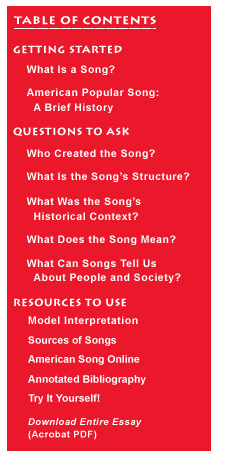talking history | syllabi | students | teachers | puzzle | about us

|
 |
| Songs serve to unify groups of people and to move them to common action or help them express common emotions. Certain songs become “anthems” for particular generations, as Bob Dylan’s “Blowin’ in the Wind” (1962) became for many in the 1960s. In times of national crisis certain songs seem especially appropriate, such as “God Bless America,” or even John Lennon’s “Imagine” (1971). They express widely-shared values or experiences and emotions that help define a group’s identity and solidarity. Songs, singers, and genres also help people construct self-images and provide models for how to behave. Pop stars–from Jenny Lind in the nineteenth century to Bing Crosby, Elvis Presley, and Britney Spears in the twentieth century–set styles and shape their fans’ attitudes. They do this, moreover, in several ways. One is by how the singer represents him or herself: Lind’s charitable contributions, Bing’s pipe, Elvis’ ducktail haircut, and Britney’s bare midriff. Genres such as punk rock or bebop provided fans with styles of dress, slang, and non-conformist identities. Song lyrics also express judgments—and even conflicts—about lifestyles, values, and appearances. In the early 1970s, for example, Neil Young released two songs expressing anti-southern opinions: “Southern Man” (1970) and “Alabama” (1972). A few years later a southern rock band, Lynard Skynard, responded with a defense of the South entitled “Sweet Home Alabama” (1974), containing the lines “I hope Neil Young will remember a southern man don’t need him around, anyhow.” Finally, music can express attitudes and values by how it sounds. Various popular forms like rock ‘n roll, and, beginning in the 1970s, such forms as punk, heavy metal, and rap, sounded defiant, like an assault on the ears, as well as the values, of older generations. Historians sometimes consider songs as more or less straightforward “reflections” of the society and culture in which they were produced. These songs are then used to illustrate what historians already think they know about that society and culture. Thus, an anti-drinking song like “Come Home Father” (1864) might be interpreted to mean that nineteenth-century Americans were concerned about alcohol and opposed to its abuse. On one level, this view of music makes sense: a musical work is a product and a part of the society and culture from which it emerges. But such a view is also highly simplistic. For one thing, it ignores the fact that songs exist in relation to other popular texts, including other songs. “Come Home Father," for example, inspired a sequel by another composer, "Father Don’t Drink any Now!” (1866) and both were part of the same musical universe as songs that treated drinking lightly, like “Pop, Pop, Pop. A Comic Song” (1868). The assumption that songs merely reflect their times also ignores the fact that songs are almost always open to multiple interpretations. For example, in the 1960s “Puff the Magic Dragon” (1963) was widely associated with marijuana and its effects. Yet the lyricist, Leonard Lipton, claimed that the song was about loss of childhood innocence. Evidently this interpretation prevailed because by the 1970s it had become standard repertory at nursery schools and children’s sing-alongs. The richness of using songs as sources for understanding history—and the need to delve deeply into the available evidence when doing so—lies in their openness to such multiple uses and interpretations. The fact that multiple uses and interpretations exist, however, points to another important aspect of music: it serves as a forum for public debate about manners, morals, politics, and social change. Musicians and their audiences are social actors; while they reflect the world around them, they also interpret and change it. For every anti-Vietnam War song like “I-Feel-Like-I’m-Fixin’-To-Die Rag” (1967) there were pro-war (or anti-anti-war) songs like “Ballad of the Green Berets” (1966). In cases like this, songs are most valuable for telling us what concerned people, how they saw issues, and how they expressed their hopes, ideals, anger, and frustrations.
Many historians have used song lyrics to help understand the culture and consciousness of the people who sang and listened to them. Especially when considering people who left few written accounts of their lives, song lyrics can give important clues about what people thought and felt, their daily struggles, and their dreams about the future. Read the following lyrics. What information do they provide about the lives of the people who created them? What stories can you tell about the singers based upon the lyrics? In 1855, former slave Frederick Douglass related hearing the following song improvised by southern slaves:
Can you use the song as evidence for: |
|

|
|

